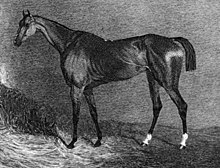Turquoise (horse)
| Turquoise | |
|---|---|
 |
|
| Sire | Selim |
| Grandsire | Buzzard |
| Dam | Pope Joan |
| Damsire | Waxy |
| Foaled | 1825 |
| Country | United Kingdom of Great Britain and Ireland |
| Colour | Brown |
| Breeder | George FitzRoy, 4th Duke of Grafton |
| Owner | Duke of Grafton |
| Trainer | Robert Stephenson |
| Record | 18:11-5-1 |
| Major wins | |
|
Oaks Stakes (1828) Town Purse (Newmarket) (1828) Town Plate (Newmarket) (1828) King's Plate (Chelmsford) (1829) |
|
Turquoise (1825–1846) was a British Thoroughbred racehorse and broodmare who won the classic Oaks Stakes at Epsom Downs Racecourse in 1828. In a racing career which lasted from April 1828 until April 1830 she ran eighteen times, winning eleven races and finishing second on five occasions. As a three-year-old in 1828 she failed to attract a bid after winning a claiming race at Newmarket but then created an upset by winning the Oaks at odds of 25/1. She went on to prove herself a leading stayer, winning three more races before the end of the season. In 1829 she won five more races including three walkovers when no horses appeared to challenge her. She was retired after a single unsuccessful run in 1830.
Turquoise was a small, lightly-built brown mare with white socks on her hind feet bred by her owner the 4th Duke of Grafton at his stud at Euston Hall in Suffolk. Her sire Selim won the Craven Stakes and the Oatlands Stakes at Newmarket and went on to have a successful stud career, siring the classic winners Azor (Epsom Derby), Medora (Oaks), Nicolo (2000 Guineas), Turcoman (2000 Guineas) and the filly by Selim (1000 Guineas) as well as the British Champion sire Sultan. Selim was British champion sire in 1814.
Turquoise's dam Pope Joan was a daughter of Prunella, described as one of the most important broodmares in the history of the Thoroughbred breed. Pope Joan herself was a successful broodmare, producing several other good winners, all of whose names began with the letter "T", including Tontine (1000 Guineas), Turcoman, Trictrac, Tiara, Trance, Titian and Talisman. Grafton sent the filly to be trained at Newmarket by Robert Robson, the so-called "Emperor of Trainers". After Robson's retirement in early 1828 the training of the filly was taken over by Robert Stephenson.
...
Wikipedia
